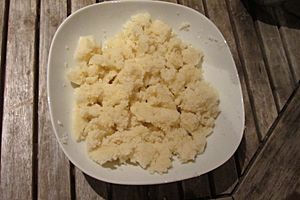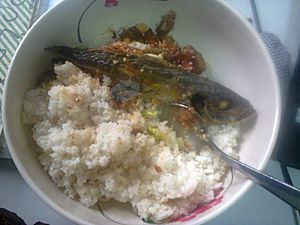Acheke facts for kids
 |
|||||||
| Alternative names | Attiéké, akyeke | ||||||
|---|---|---|---|---|---|---|---|
| Course | Side dish | ||||||
| Place of origin | Southern Côte d'Ivoire, Western Ghana | ||||||
| Region or state | West Africa | ||||||
| Main ingredients | Fermented and grated cassava | ||||||
| Variations | 2 | ||||||
|
|||||||
Acheke (also spelled Attiéké in Ivory Coast, or Akyeke in Ghana) is a popular side dish from West Africa. It is made from cassava, a starchy root vegetable. The dish is prepared by fermenting and grating the cassava pulp. Sometimes, dried attiéké is made, which feels a lot like couscous.
Acheke is a special food in Ivory Coast, especially for people from the southeast region. It tastes great when eaten with fried fish and a spicy pepper sauce. This sauce often has chopped pepper, onion, and a little seasoning. Sometimes, palm oil is added to give it a yellowish color and a different flavor. You can also enjoy acheke with smoked fish and stew, or even with soup.
How Acheke is Made
Making acheke starts with peeling and grating the cassava. A small amount of already fermented cassava, called a "starter," is then mixed in. This starter has different names depending on the local group, like mangnan Ebrié lidjrou or bêdêfon.
The cassava paste is left to ferment for one or two days. This fermentation process is important. It helps to remove a natural substance called hydrocyanic acid, which is found in raw cassava. After fermenting, the pulp is drained to remove water. Then, it is sifted and dried.
Finally, the acheke is cooked by steaming the pulp for a few minutes. Once steamed, it's ready to eat! It is often served with grilled fish and a side of pepper or tomato sauce.
You can often find precooked attiéké at markets. This makes it very easy to prepare at home. You just need to heat it up, usually for about 10 minutes in a microwave.
See also
 In Spanish: Attiéké para niños
In Spanish: Attiéké para niños


